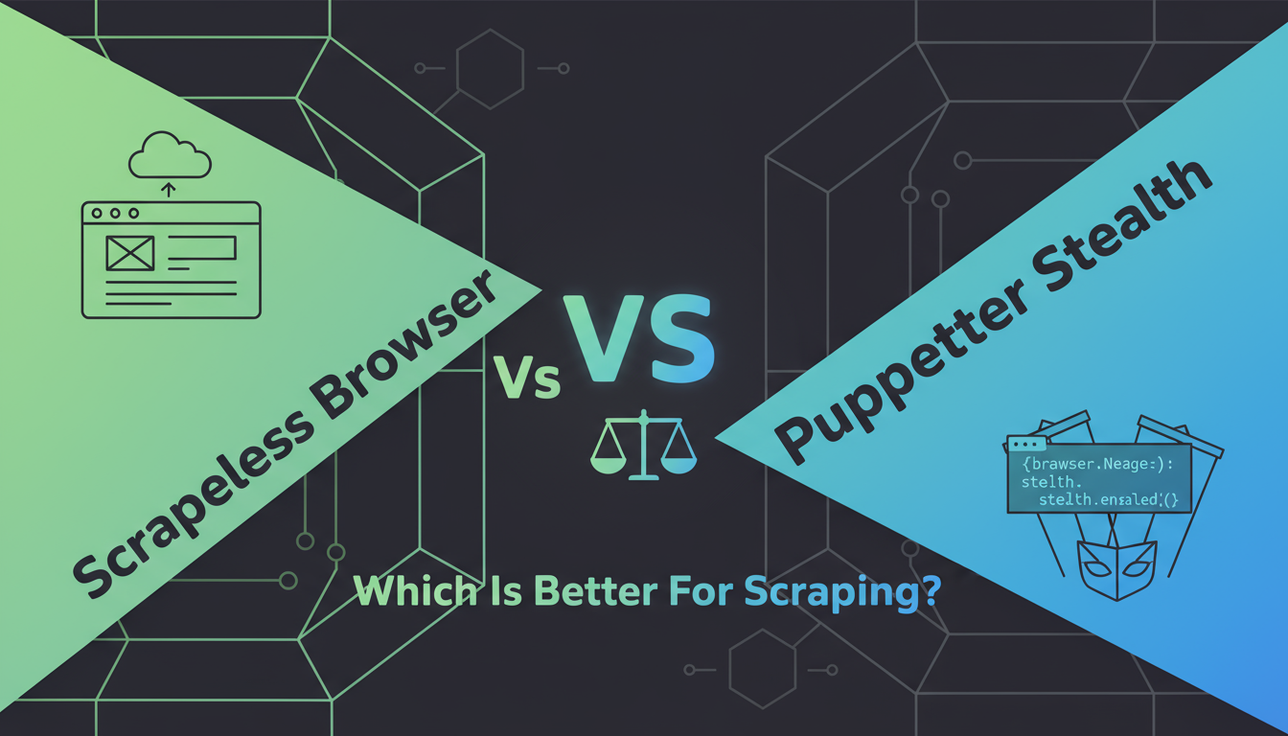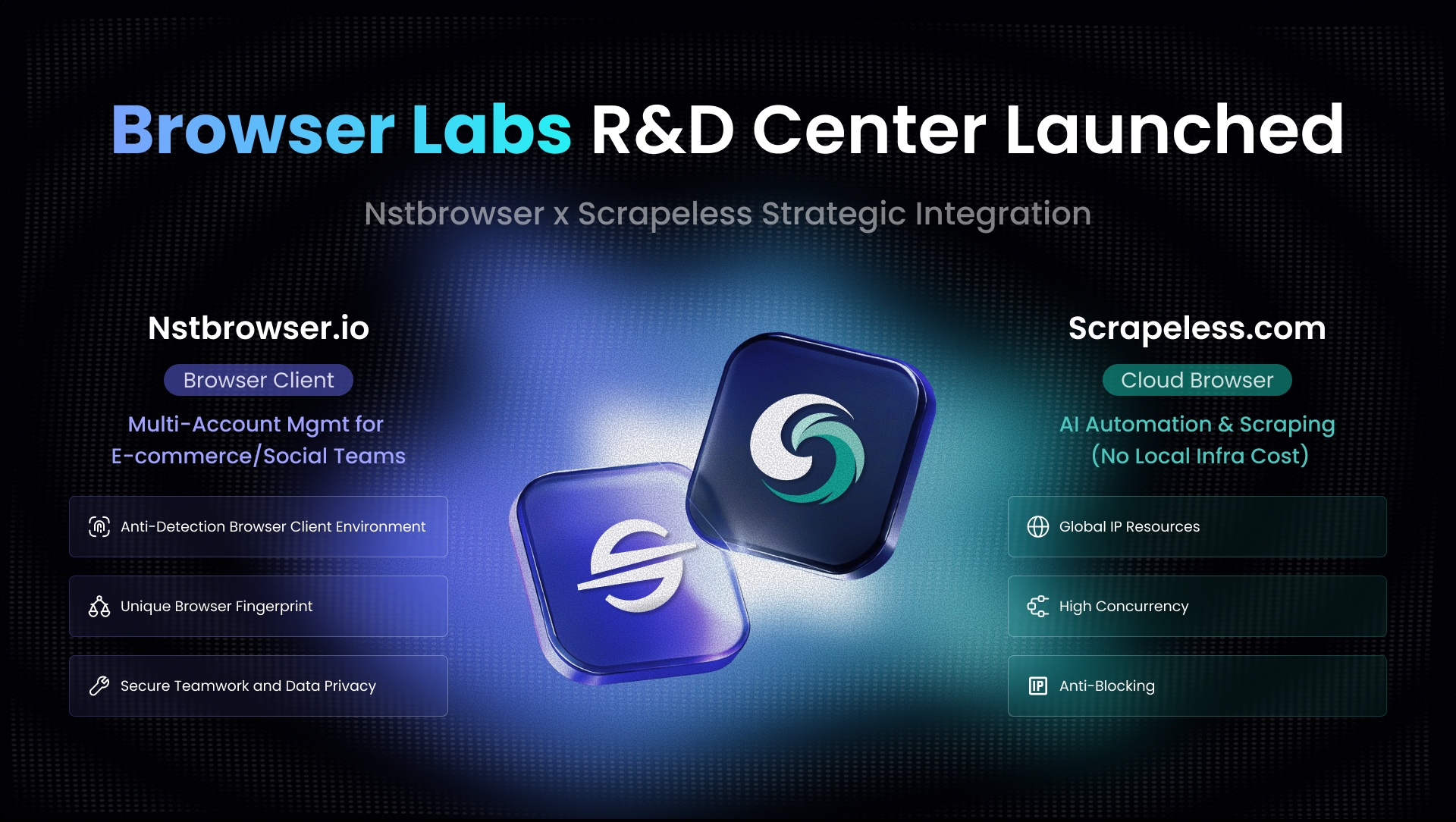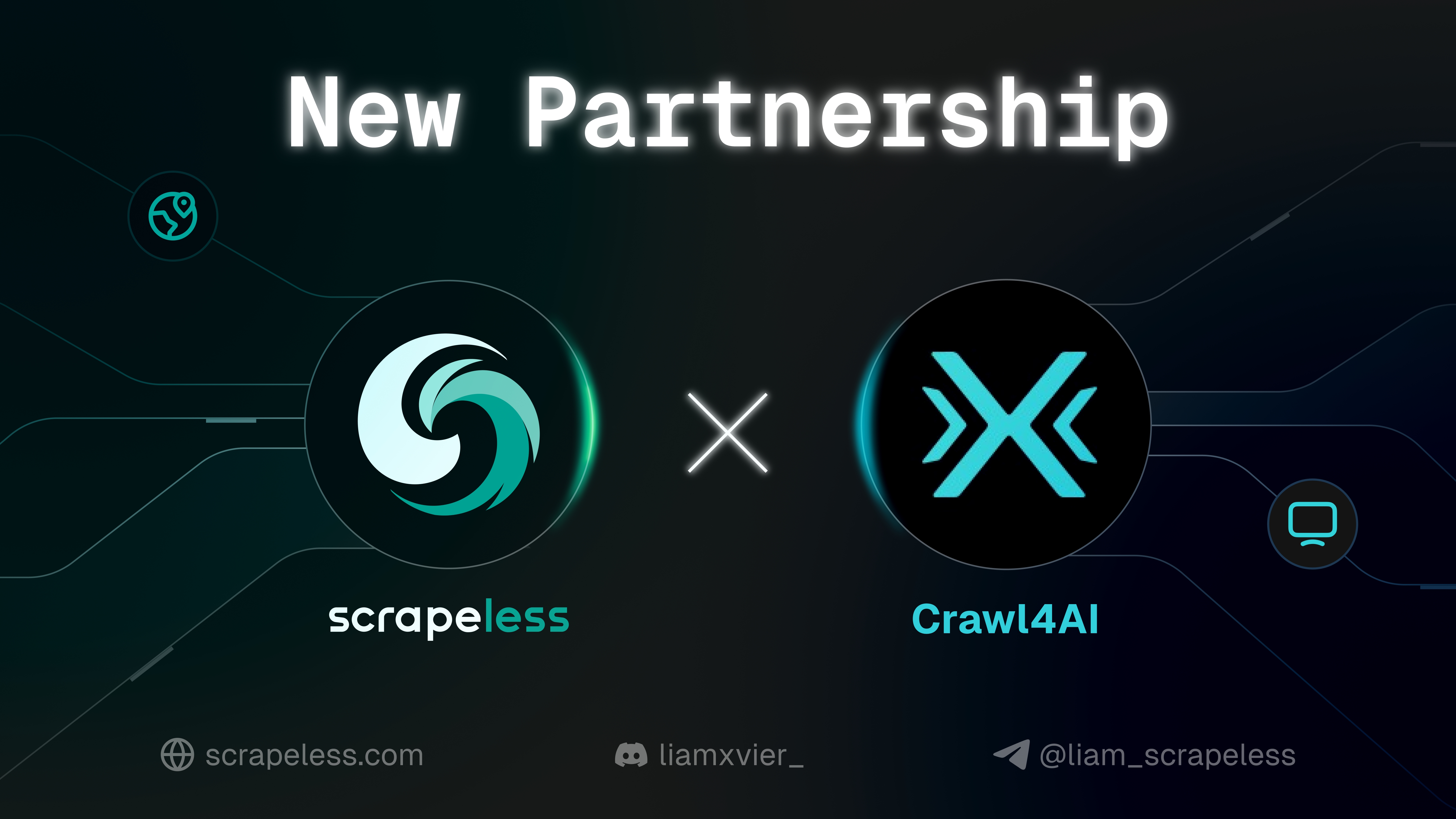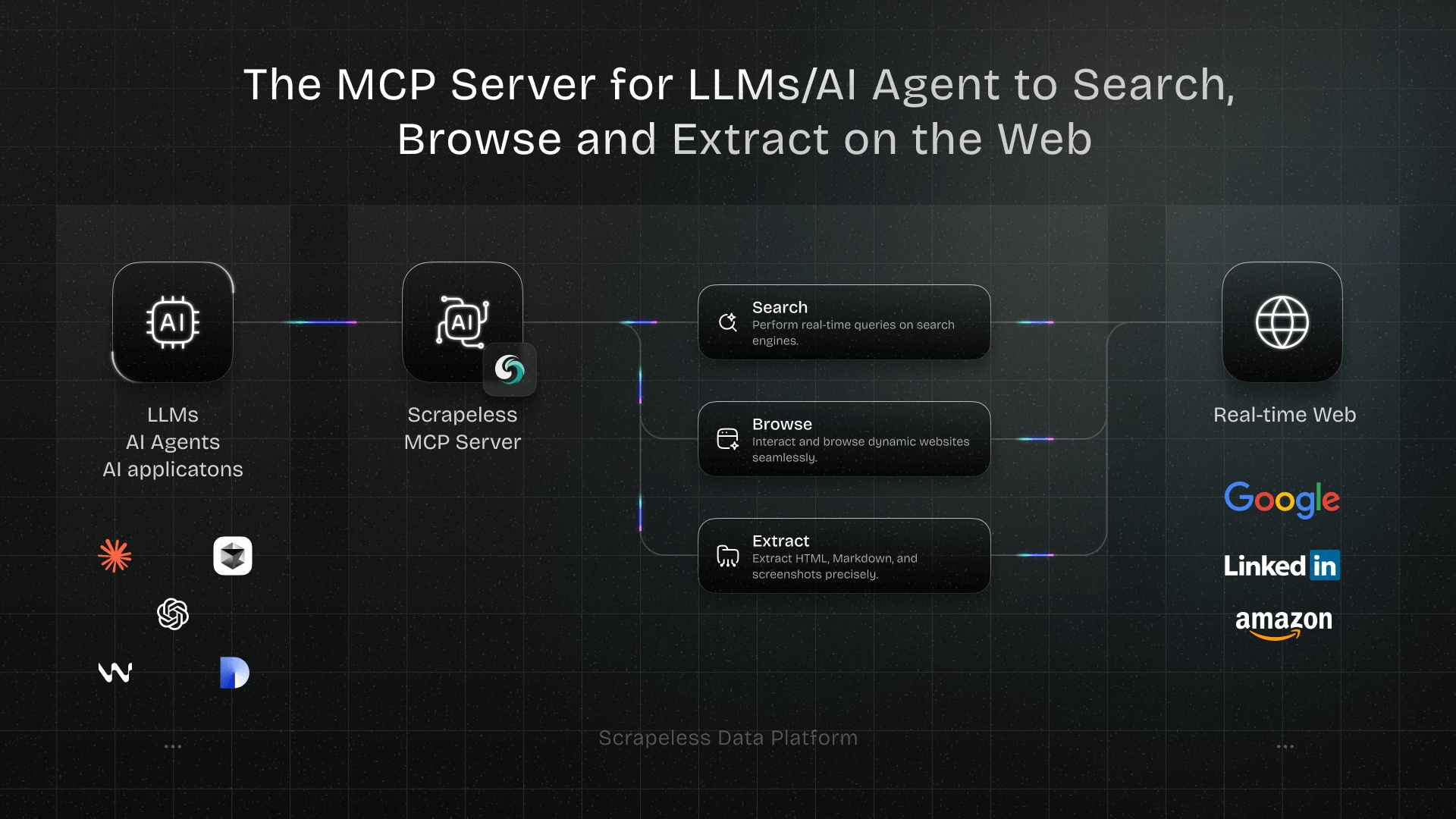Scrapeless Browser Vs Puppeteer Stealth: Which Is Better For Scraping?
Expert in Web Scraping Technologies
In the dynamic world of web scraping, the battle against sophisticated anti-bot systems is constant. Developers and data enthusiasts are continually seeking robust tools to extract data efficiently and reliably. Two prominent contenders in this arena are Scrapeless Browser and Puppeteer Stealth. While Puppeteer Stealth offers a powerful plugin to enhance Puppeteer's anti-detection capabilities, Scrapeless Browser emerges as a more comprehensive, integrated, and often superior solution for web scraping, especially for those prioritizing ease of use, scalability, and high success rates against advanced anti-bot measures. This article will delve into a detailed comparison of these two technologies, exploring their strengths, weaknesses, and ideal use cases to help you determine which is better for your scraping needs.
Key Takeaways
- Puppeteer Stealth is a plugin that enhances Puppeteer's ability to evade bot detection by modifying browser fingerprints.
- Scrapeless Browser is a fully integrated, cloud-based headless browser solution specifically designed for web scraping, offering advanced anti-detection and AI-powered features.
- While Puppeteer Stealth requires coding and manual integration of various plugins for comprehensive anti-detection, Scrapeless Browser provides an all-in-one, managed service.
- Scrapeless Browser excels in ease of use, scalability, and handling complex anti-bot systems due to its AI-driven approach and cloud infrastructure.
- For developers comfortable with coding and fine-grained control, Puppeteer Stealth offers flexibility; however, for efficiency, reliability, and reduced maintenance, Scrapeless Browser is often the better choice.
- The choice between the two depends on project complexity, technical expertise, budget, and the desired level of abstraction from infrastructure management.
The Evolution of Web Scraping: Headless Browsers and Anti-Detection
Web scraping has evolved significantly from simple HTTP requests to complex interactions with dynamic, JavaScript-heavy websites. This evolution necessitated the use of headless browsers—browsers without a graphical user interface—that can programmatically control web pages, execute JavaScript, and render content just like a regular browser. Tools like Puppeteer quickly became indispensable for developers seeking to automate browser tasks and extract data from modern web applications.
However, as scraping techniques advanced, so did anti-bot technologies. Websites, particularly those with valuable data, deployed sophisticated detection mechanisms to identify and block automated traffic. These mechanisms analyze various browser fingerprints, behavioral patterns, and network characteristics to distinguish between human users and bots. This arms race led to the development of anti-detection techniques, aiming to make headless browsers appear more human-like. In this context, solutions like Puppeteer Stealth emerged to enhance the stealth capabilities of traditional headless browsers, while integrated platforms like Scrapeless Browser offer a more holistic and managed approach to overcoming these challenges.
Puppeteer Stealth: Enhancing Open-Source Headless Browsing
Puppeteer is a Node.js library developed by Google that provides a high-level API to control Chrome or Chromium over the DevTools Protocol. It allows developers to automate browser tasks such as generating screenshots, creating PDFs, navigating pages, and, crucially, web scraping. While powerful, Puppeteer in its default headless mode leaves several tell-tale signs that can be easily detected by anti-bot systems. This is where Puppeteer Stealth comes into play.
What is Puppeteer Stealth?
Puppeteer Stealth, officially known as puppeteer-extra-plugin-stealth, is an extension built on top of puppeteer-extra. Its primary purpose is to modify Puppeteer's default settings and behaviors to make it more difficult for websites to detect automated browsing activities. It achieves this by patching various browser properties and functions that are commonly used by anti-bot scripts to identify headless browsers. The plugin operates on the principle that while it may be impossible to prevent all forms of detection, it can make detection so challenging that it becomes cost-prohibitive or generates too many false positives for anti-bot systems to be effective [1].
Key Evasion Modules and How They Work
Puppeteer Stealth includes a suite of evasion modules, each targeting a specific detection vector:
- User-Agent Override: By default, Puppeteer's user agent string often contains "HeadlessChrome," a clear indicator of automation. This module modifies the user agent to mimic a standard browser, removing this giveaway. It also ensures the
Accept-Languageheader matches the user agent, preventing another common red flag. navigator.webdriverProperty: One of the most common bot detection methods is checking thenavigator.webdriverproperty, which istruein headless browsers. Puppeteer Stealth removes or spoofs this property, making the browser appear as if it's controlled by a human.chrome.appandchrome.csiObjects: Regular Chrome browsers havechrome.appandchrome.csiobjects, which are typically absent in headless instances. This module injects these objects, further enhancing the browser's human-like appearance.WebGLFingerprinting: Websites can use WebGL to generate unique browser fingerprints. Stealth attempts to spoof or randomize certain WebGL parameters to prevent consistent fingerprinting.PermissionsAPI Spoofing: The Permissions API can reveal if a browser is headless. Stealth modifies the behavior of this API to return values consistent with a human-controlled browser.MediaDevicesSpoofing: Similar to permissions, theMediaDevicesAPI can be used for fingerprinting. Stealth ensures that the responses from this API are consistent with a non-headless browser.Navigator.pluginsandNavigator.mimeTypes: Headless browsers often have different or fewer plugins and MIME types listed than standard browsers. Stealth patches these properties to reflect a more common browser configuration.Navigator.hardwareConcurrencyandNavigator.deviceMemory: These properties can be used to infer the environment. Stealth can spoof these values to appear more generic or human-like.
Code Operation Steps for Puppeteer Stealth
To use Puppeteer Stealth, you first need to install Puppeteer, puppeteer-extra, and puppeteer-extra-plugin-stealth:
bash
npm install puppeteer puppeteer-extra puppeteer-extra-plugin-stealthOnce installed, you can integrate it into your Node.js script:
javascript
const puppeteer = require('puppeteer-extra');
const StealthPlugin = require('puppeteer-extra-plugin-stealth');
puppeteer.use(StealthPlugin());
(async () => {
const browser = await puppeteer.launch({ headless: true });
const page = await browser.newPage();
// Navigate to a website that detects bots
await page.goto('https://nowsecure.nl/');
// You can perform scraping actions here
const pageTitle = await page.title();
console.log('Page Title:', pageTitle);
await browser.close();
})();This basic setup launches a headless Chrome instance with the Stealth plugin applied. The page.goto() command navigates to a URL, and subsequent Puppeteer commands can be used for data extraction. For more advanced scenarios, developers often combine Puppeteer Stealth with other puppeteer-extra plugins for proxy management (puppeteer-extra-plugin-proxy) and CAPTCHA solving (puppeteer-extra-plugin-recaptcha) [2].
Strengths of Puppeteer Stealth
- Flexibility and Control: Developers have granular control over browser automation and can customize evasion strategies.
- Open-Source Community: Benefits from a vibrant open-source community, offering continuous updates and support.
- Cost-Effective for Developers: For those with coding expertise, it's a free solution to enhance Puppeteer's stealth capabilities.
- Integration with Node.js Ecosystem: Seamlessly integrates into existing Node.js projects.
Weaknesses of Puppeteer Stealth
- Requires Coding Expertise: Not a no-code solution; requires proficiency in JavaScript/Node.js.
- Manual Integration: Advanced anti-detection often requires integrating multiple plugins and managing proxies/CAPTCHAs manually.
- Ongoing Maintenance: Anti-bot systems constantly evolve, requiring continuous updates and adjustments to evasion strategies.
- Scalability Challenges: Managing a large fleet of Puppeteer instances with proxies and anti-detection can be complex and resource-intensive.
- Not Foolproof: While effective, it's not a guaranteed solution against all advanced anti-bot measures, as acknowledged by its developers [1].
Scrapeless Browser: The Integrated, AI-Powered Solution
Scrapeless Browser represents a paradigm shift in web scraping, moving beyond individual tools and plugins to offer a fully integrated, cloud-based solution. It's a specialized headless browser designed from the ground up for web scraping, incorporating advanced AI and anti-detection technologies to ensure high success rates against even the most sophisticated anti-bot systems, including Cloudflare, reCAPTCHA, and other complex JavaScript challenges. Unlike Puppeteer Stealth, which is a component within a developer's toolkit, Scrapeless Browser is a complete, managed service that handles all the underlying complexities.
What is Scrapeless Browser?
Scrapeless Browser is a customizable, anti-detection cloud browser powered by a self-developed Chromium core. It operates in a globally distributed cloud environment, mimicking human behavior and rendering JavaScript to load dynamic content seamlessly. Its core strength lies in its ability to provide a highly realistic browser environment that is difficult for anti-bot systems to distinguish from a genuine human user. It's built for AI agents and automated task execution, offering high concurrency and bulk scraping capabilities [3].
Key Features and How They Provide Superior Scraping
- Human-Like Behavior (AI-Driven): Scrapeless Browser uses AI technology to simulate realistic clicks, scrolls, typing, and navigation patterns. This goes beyond simple property spoofing, creating behavioral fingerprints that are incredibly difficult for anti-bot systems to detect. This precise mimicry of human behavior during page loading and navigation makes it nearly impossible to distinguish between humans and bots [3].
- High Performance and Scalability: Operating server-side in a cloud environment, Scrapeless Browser leverages advanced browser and protocol emulation technologies. This results in superior realism and performance, often being 10 times more efficient than traditional browser modes. It supports large-scale concurrent visits, making it ideal for high-volume data extraction without taxing local resources [3].
- Dynamic Page Data Detection and Bypass: The system efficiently detects dynamic web page data and automatically configures scraping settings. Crucially, it executes anti-bot dynamic JavaScript to accurately generate encryption parameters, ensuring a complete bypass of detection mechanisms. This includes handling complex JavaScript challenges and CAPTCHAs automatically [3].
- Automated Proxy Management: Unlike Puppeteer Stealth, where proxy integration is often a separate plugin, Scrapeless Browser includes a globally distributed, managed proxy network. It automatically rotates IPs, handles proxy types (residential, datacenter), and ensures optimal proxy performance without any manual configuration from the user.
- Advanced Browser Fingerprint Customization: Scrapeless Browser dynamically customizes fingerprint parameters such as User-Agent, device type, screen resolution, language settings, and more. This dynamic stealth mode ensures that the browser environment always appears legitimate and unique, effectively evading detection [4].
- Built-in CAPTCHA Solving: For websites protected by CAPTCHAs, Scrapeless Browser integrates automated CAPTCHA solving capabilities, eliminating the need for third-party services or manual intervention, which is often required with Puppeteer Stealth.
- Ease of Use (No-Code/Low-Code Interface): While offering enterprise-grade power, Scrapeless Browser maintains an intuitive interface. Users can define scraping rules visually or via a simplified API, abstracting away the complexities of headless browser management, proxy rotation, and anti-detection. This makes it accessible to both developers and non-technical users.
- Reliability and Uptime: As a managed cloud service, Scrapeless Browser guarantees high uptime and consistent performance, ensuring that scraping tasks run reliably without interruptions, a significant advantage over self-managed Puppeteer setups.
- Compliance and Ethical Scraping: Scrapeless is committed to ethical data collection, supporting the collection of publicly available data while strongly opposing unauthorized or unapproved sensitive information. It provides features to help users regulate compliance [3].
- Full-Stack Web Scraping Solution: Scrapeless is not just a browser; it's a full-stack web scraping solution that combines the browser, API, web unlocker, CAPTCHA solver, and proxy services under one roof. This integrated approach simplifies the entire data extraction workflow [5].
Code Operation Steps for Scrapeless Browser (API-driven)
While Scrapeless Browser offers visual interfaces, its core power can be accessed via a simple API, making it incredibly easy to integrate into any application without managing browser instances or proxies:
python
import requests
url = "https://api.scrapeless.com/v1/scrape"
headers = {
"Authorization": "Bearer YOUR_API_KEY",
"Content-Type": "application/json"
}
payload = {
"target_url": "https://www.example.com",
"render_js": True, # Enable JavaScript rendering
"wait_for_selector": ".product-title", # Wait for a specific element to appear
"extract_rules": {
"title": "h1",
"price": ".price-tag"
}
}
response = requests.post(url, headers=headers, json=payload)
if response.status_code == 200:
data = response.json()
print("Scraped Data:", data)
else:
print("Error:", response.status_code, response.text)This Python snippet demonstrates how to use the Scrapeless API. You simply provide the target URL, specify if JavaScript rendering is needed, define extraction rules using CSS selectors, and Scrapeless handles the rest—including launching a headless browser, managing proxies, bypassing anti-bot measures, and returning structured data. This level of abstraction is a significant advantage over the manual configuration required for Puppeteer Stealth.
Direct Comparison: Scrapeless Browser vs. Puppeteer Stealth
To better understand which solution is superior for various scraping needs, let's directly compare Scrapeless Browser and Puppeteer Stealth across several critical dimensions:
| Feature / Aspect | Puppeteer Stealth | Scrapeless Browser |
|---|---|---|
| Nature of Solution | Plugin for Puppeteer (Node.js library) | Integrated, Cloud-based Headless Browser Service |
| Ease of Use | Requires coding, manual setup of plugins | Visual interface, simple API, managed service (very easy) |
| Anti-Detection | Patches specific browser properties; requires ongoing updates and additional plugins for full coverage | AI-driven, dynamic stealth mode, behavioral mimicry, automated (excellent) |
| Proxy Management | Requires puppeteer-extra-plugin-proxy or external proxy integration |
Automated, globally distributed, managed proxy network (built-in) |
| CAPTCHA Solving | Requires puppeteer-extra-plugin-recaptcha or external services |
Automated, built-in CAPTCHA solver |
| Scalability | Manual management of multiple instances, resource-intensive | Cloud-native, high concurrency, scales automatically (excellent) |
| JavaScript Rendering | Yes, inherent to Puppeteer | Yes, inherent to Scrapeless Browser, optimized for anti-bot |
| Maintenance | High (updates, anti-bot adjustments, proxy management) | Low (managed service, automatic updates) |
| Cost | Free (plugin), but high operational costs for proxies, CAPTCHA, infrastructure | Subscription-based (cost-effective for reliable, large-scale scraping) |
| Ideal User | Developers seeking fine-grained control, small-scale projects | Developers and non-developers seeking reliable, scalable, and easy web scraping |
Why Scrapeless Browser is the Better Choice for Most Scraping Needs
While Puppeteer Stealth offers a valuable tool for developers to enhance their Puppeteer-based scrapers, Scrapeless Browser emerges as the superior choice for the vast majority of web scraping applications, particularly for those prioritizing efficiency, reliability, and ease of management. Here's why:
- True "Set-and-Forget" Anti-Detection: Scrapeless Browser handles the entire anti-detection lifecycle automatically. You don't need to worry about which browser properties to spoof, how to rotate proxies, or how to solve CAPTCHAs. Its AI-driven approach constantly adapts to new anti-bot measures, providing a level of resilience that is difficult to achieve with a self-managed Puppeteer Stealth setup.
- Reduced Development and Maintenance Overhead: For developers, the time spent integrating multiple plugins, managing proxies, and debugging anti-detection issues with Puppeteer Stealth can be substantial. Scrapeless Browser abstracts all this complexity, allowing developers to focus on data utilization rather than infrastructure management. For non-developers, it opens up web scraping entirely.
- Inherent Scalability: Scaling Puppeteer instances to handle millions of requests concurrently, especially with advanced anti-detection, is a significant engineering challenge. Scrapeless Browser is built on a cloud-native architecture, offering effortless scalability and high performance without requiring users to manage servers or infrastructure.
- Cost-Effectiveness for Production: While Puppeteer Stealth is technically free, the hidden costs of managing proxies, CAPTCHA solvers, and cloud infrastructure for large-scale, reliable scraping can quickly surpass the cost of a managed service like Scrapeless. Scrapeless charges for successful data extraction, providing predictable costs and better ROI for production-grade scraping.
- Focus on Data, Not Infrastructure: Ultimately, the goal of web scraping is to acquire data. Scrapeless Browser allows users to focus purely on defining what data they need, while it handles the complex process of acquiring it reliably, making the entire workflow more efficient and productive.
For projects that demand consistent, large-scale, and reliable data extraction from dynamic and anti-bot protected websites, Scrapeless Browser offers a more robust, efficient, and user-friendly solution than a self-implemented Puppeteer Stealth setup. It provides the power of a headless browser with the intelligence of AI and the convenience of a managed cloud service.
External Authoritative Data and Sources
- The official documentation for
puppeteer-extra-plugin-stealthacknowledges the inherent difficulty in preventing all forms of headless browser detection, stating that the goal is to make it "cost-prohibitive or triggers too many false-positives to be feasible." Puppeteer-Extra-Plugin-Stealth GitHub - ScrapingAnt blog post discusses how Puppeteer Stealth can be combined with other
puppeteer-extraplugins for proxy management and CAPTCHA solving to avoid detection. ScrapingAnt Blog - Scrapeless official product page for Scraping Browser highlights its AI technology for human-like behavior simulation, high performance, and dynamic page data detection. Scrapeless Scraping Browser
- A dev.to article details how Scrapeless Scraping Browser offers dynamic stealth mode support and browser fingerprint customization to bypass restrictions. Dev.to - Scrapeless Browser Fingerprint Customization
Internal Links to Scrapeless Blog
- For a deeper dive into advanced scraping techniques, read our article on Scrapeless AI Web Scraping Vs Traditional Scrapers: A Complete Guide.
- Learn about the future of automation with our Headless Cloud Browser For AI And Automation (Ultimate 2025 Guide).
- Discover how no-code solutions are democratizing data extraction in No-Code Web Scraping Services For Beginners (Easy & Fast Setup).
Conclusion: The Future of Web Scraping is Integrated and Intelligent
The choice between Scrapeless Browser and Puppeteer Stealth ultimately boils down to your project's specific needs, technical expertise, and desired level of abstraction. While Puppeteer Stealth offers a powerful, open-source solution for developers to enhance their custom scrapers, it demands significant coding, integration, and ongoing maintenance efforts to stay ahead of evolving anti-bot measures.
For most web scraping tasks, especially those requiring high reliability, scalability, and minimal operational overhead, Scrapeless Browser stands out as the superior choice. Its integrated, AI-powered, cloud-based approach handles all the complexities of headless browser management, proxy rotation, and anti-detection automatically. This allows users, whether developers or non-technical professionals, to achieve consistent and accurate data extraction without getting bogged down in infrastructure challenges. In the ever-evolving landscape of web data, choosing an intelligent, all-in-one solution like Scrapeless is not just a convenience—it's a strategic advantage.
Ready to elevate your web scraping with an intelligent, integrated solution?
Try Scrapeless for Free Today!
Frequently Asked Questions (FAQ)
Q1: What is the main difference between Puppeteer Stealth and Scrapeless Browser?
Puppeteer Stealth is a plugin for the Puppeteer library that helps developers make their headless Chrome browsers less detectable. Scrapeless Browser, on the other hand, is a fully integrated, cloud-based headless browser service that handles all aspects of web scraping, including advanced anti-detection, proxy management, and AI-powered data extraction, as a managed solution.
Q2: Do I need coding skills to use Puppeteer Stealth or Scrapeless Browser?
Yes, you need coding skills (JavaScript/Node.js) to implement and manage Puppeteer Stealth, as it's a library plugin. Scrapeless Browser is designed to be more user-friendly, offering both visual interfaces and a simplified API, making it accessible to users with varying levels of technical expertise, including those with no coding background.
Q3: Which is better for bypassing advanced anti-bot systems like Cloudflare?
While Puppeteer Stealth can help, it often requires additional plugins and continuous manual adjustments to bypass advanced anti-bot systems effectively. Scrapeless Browser is specifically engineered with AI-driven, dynamic stealth modes and automated proxy management, making it highly effective and reliable for bypassing sophisticated anti-bot measures like Cloudflare and reCAPTCHA without user intervention.
Q4: How does scalability compare between the two?
Scaling Puppeteer Stealth to handle large volumes of concurrent requests is a complex engineering task that requires significant resource management. Scrapeless Browser is a cloud-native service built for high performance and scalability, automatically managing infrastructure and resources to handle large-scale data extraction efficiently.
Q5: Can I use my own proxies with Scrapeless Browser?
Scrapeless Browser comes with its own globally distributed, managed proxy network, which is automatically optimized for anti-detection. This eliminates the need for users to manage their own proxies, simplifying the entire scraping process and ensuring high success rates. While it integrates its own proxies, its design focuses on abstracting this complexity from the user.
At Scrapeless, we only access publicly available data while strictly complying with applicable laws, regulations, and website privacy policies. The content in this blog is for demonstration purposes only and does not involve any illegal or infringing activities. We make no guarantees and disclaim all liability for the use of information from this blog or third-party links. Before engaging in any scraping activities, consult your legal advisor and review the target website's terms of service or obtain the necessary permissions.



